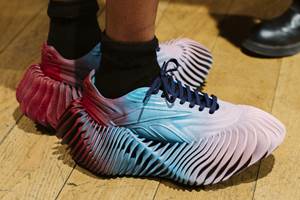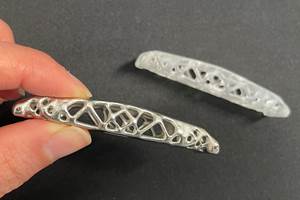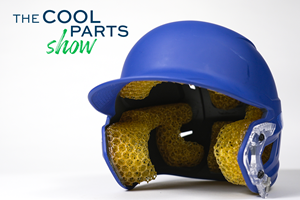EOS’ AlSi10Mg and Virtucycle Take-Back Program Support Sustainable Additive Manufacturing
Both the reformulated AlSi10Mg and new polymer take-back program are designed to help reduce material waste in manufacturing.
Share
Read Next
EOS’ aluminum AlSi10Mg material and its Virtucycle used polymer take-back program both help minimize the climate impact of additive manufacturing (AM). The AlSi10Mg is the latest addition to the company’s Responsible Products manufacturing portfolio, while the polymer take-back program helps to reduce material waste.
The reformulated AlSi10Mg is an example of its efforts for sustainability in 3D printing through more eco-friendly product development. Aluminium AlSi10Mg — which is one of the most popular products in its portfolio — now incorporates a minimum of 30% recycled feedstock, thereby achieving a 25% CO2e reduction compared to the prior formulation.
The company says the new formulation maintains the same properties, characteristics and performance in additively manufactured parts, helping ensure existing EOS Aluminium AlSi10Mg customers do not need to requalify applications. Specifications for AlSi10Mg remain unchanged. The chemical composition standard is AlSi10Mg with an ultimate tensile strength of 460 MPa and a yield strength of 245 MPa. The elongation at break is 5%. It also boasts good thermal and electrical conductivity with the possibility of heat treatment.
“Our commitment to offering responsible products that support AM production is growing to include our metal materials,” says Sophia Heyl, product specialist, metal materials at EOS. “We are striving to create carbon footprint transparency for our premium metal materials. These externally verified numbers are also providing transparency to our customers by including these materials in our Carbon Calculator, furthering sustainability initiatives for both our customers and for EOS.”
Virtucycle Used Polymer Material Take-Back Program Now Available
EOS has also partnered with Agiplast, an Arkema company, to offer its new Virtucycle program. The Virtucycle program takes used polymer material and components, using 100% sustainably sourced energy, to transform AM powder into recycled, high-performance injection molding granules. To verify the positive impact of this circular economy program, EOS performed a life cycle analysis, externally verified by TÜV Süd, confirming 1 kg of polymer material turned into 0.945 kg* granules, saves approximately 7 kg CO2e in comparison to raw material. (* The difference stems from losses in the process.)
EOS says it is continuously identifying and reducing CO2e emissions throughout its supply chain, expanding the responsible mindset to encompass all areas of its business. Additional EOS Responsible Products currently available include:
- PA 1101 ClimateNeutral with 100% proven quality and zero CO2e, ClimateNeutral materials are biobased products where all remaining GHG emissions are offset with Gold Standard carbon credits.
- PA 2200 CarbonReduced materials and products where GHG emissions are reduced significantly by suitable measures such as green energy in the production process.
- Carbon Calculator considers AM project carbon emissions with key cost metrics to provide an estimation of the organization’s AM CO2e and expenses.
“I am delighted that we are continuing our way towards Responsible Manufacturing and expanding our portfolio of Responsible Products stepwise,” says Björn Hannappel, head of sustainability, EOS. “By minimizing waste, reducing the environmental footprint and prioritizing eco-friendly materials, organizations can both protect our planet and create a more efficient and resilient business model.”
Related Content
Concept Sneaker Boasts One-Piece 3D Printed TPU Construction
The Reebok x Botter Concept Sneaker Engineered by HP premiered at Paris Fashion Week, hinting at manufacturing possibilities for the future of footwear.
Read MorePossibilities From Electroplating 3D Printed Plastic Parts
Adding layers of nickel or copper to 3D printed polymer can impart desired properties such as electrical conductivity, EMI shielding, abrasion resistance and improved strength — approaching and even exceeding 3D printed metal, according to RePliForm.
Read More3D Printed Lattices Replace Foam for Customized Helmet Padding: The Cool Parts Show #62
“Digital materials” resulting from engineered flexible polymer structures made through additive manufacturing are tunable to the application and can be tailored to the head of the wearer.
Read MoreThis Drone Bird with 3D Printed Parts Mimics a Peregrine Falcon: The Cool Parts Show #66
The Drone Bird Company has developed aircraft that mimic birds of prey to scare off problem birds. The drones feature 3D printed fuselages made by Parts on Demand from ALM materials.
Read MoreRead Next
3D Printed Polymer EOAT Increases Safety of Cobots
Contract manufacturer Anubis 3D applies polymer 3D printing processes to manufacture cobot tooling that is lightweight, smooth and safer for human interaction.
Read MoreBike Manufacturer Uses Additive Manufacturing to Create Lighter, More Complex, Customized Parts
Titanium bike frame manufacturer Hanglun Technology mixes precision casting with 3D printing to create bikes that offer increased speed and reduced turbulence during long-distance rides, offering a smoother, faster and more efficient cycling experience.
Read MoreProfilometry-Based Indentation Plastometry (PIP) as an Alternative to Standard Tensile Testing
UK-based Plastometrex offers a benchtop testing device utilizing PIP to quickly and easily analyze the yield strength, tensile strength and uniform elongation of samples and even printed parts. The solution is particularly useful for additive manufacturing.
Read More





















